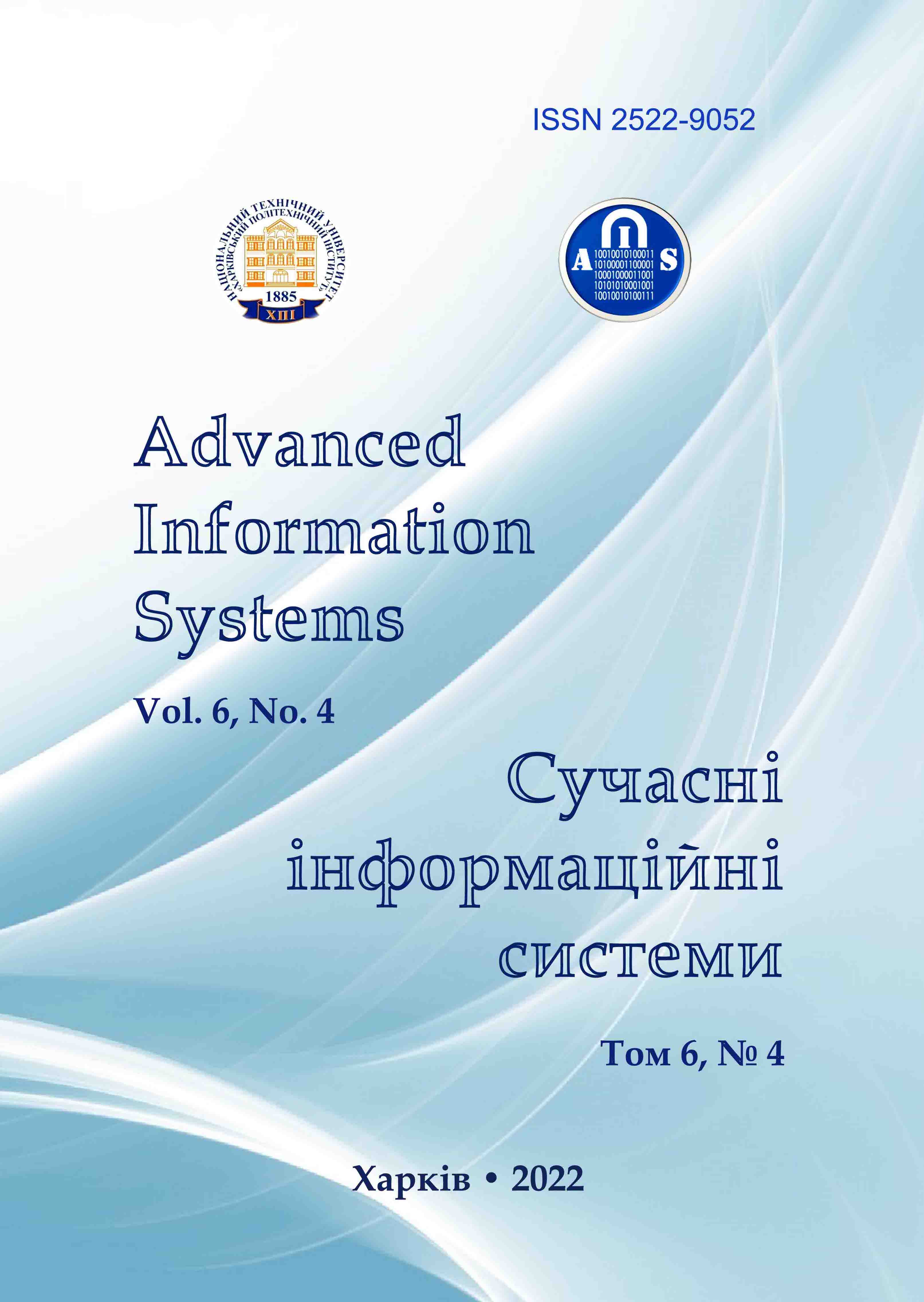COMPARATIVE STUDIES OF METHODS FOR IMPROVING THE CYBER SECURITY OF UNMANNED AERIAL VEHICLES WITH THE BUILT-IN ADS-B SYSTEM
Main Article Content
Abstract
The subject of study in the article is methods for improving the cybersecurity of unmanned aerial vehicles with an integrated ADS-B system. The aim is to analyze and compare methods for improving the cybersecurity of unmanned aerial vehicles with an embedded ADS-B system. Particular scientific tasks: analysis and comparative studies of the main types of cyber threats and methods for improving the cybersecurity of unmanned aerial vehicles with an integrated ADS-B system, the development of an appropriate taxonomy, and the development of proposals for further research. The methods used in the article are the methods of system analysis. The following research results have been obtained: a classification of cyber threats to the security of unmanned aerial vehicles with an integrated ADS-B system has been developed; a taxonomy of ADS-B message modification and injection attacks has been developed; practical UAV security metrics adapted to the presented taxonomy of cyberattacks are defined and researched ; chosen most priority directions research ; - a generalized classification of cryptographic protection methods adapted to solve the problems of improving the security of UAVs with an integrated ADS-B system has been developed; the use of additional means of identification based on steganographic methods of data protection is proposed. Conclusions. An analysis and comparative studies have been carried out, and a generalized classification of methods for improving the cybersecurity of unmanned aerial vehicles with an integrated ADS-B system has been developed. Their advantages and disadvantages are revealed, which made it possible to determine the priority of further research and possible promising ways to solve the tasks.
Article Details
References
Krishnan, Rahul & Rajendran, Ganesh Babu & Kaviya, S. & Kumar, N. & Rahul, C. & Raman, S. (2017), “Software de-fined radio (SDR) foundations, technology tradeoffs: A survey”, 2017 IEEE International Conference on Power, Con-trol, Signals and Instrumentation Engineering (ICPCSI), рр. 2677-2682, doi: https://doi.org/10.1109/ICPCSI.2017.8392204.
(2010), 14 CFR Part 91, Automatic Dependent Surveillance Broadcast (ADS-B) Out Performance Requirements to Support Air Traffic Control (ATC) Service; Final Rule. May 28, 2010, ICC.
Alghamdi, Fatimah, Alshhrani, Amal & Hamza, Nermin (2018), “Effective Security Techniques for Automatic Depend-ent Surveillance-Broadcast (ADS-B)”, International Journal of Computer Applications, Vol. 180, pp. 23–28, doi: https://doi.org/10.5120/ijca2018916598.
Kacem, Thabet, Wijesekera, Duminda, Costa, Paulo & de Barros Barreto, Alexandre (2014), “Security requirements analysis of ADS-B networks”, CEUR Workshop Proceedings, 1304, pp. 40–47, available at: https://ceur-ws.org/Vol-1304/STIDS2014_T06_KacemEtAl.pdf.
Manesh, Mohsen Riahi & Kaabouch, Naima (2017), “Analysis of vulnerabilities, attacks, countermeasures and overall risk of the Automatic Dependent Surveillance-Broadcast (ADS-B) system”, International Journal of Critical Infrastructure Protection, 19, doi: https://doi.org/10.1016/j.ijcip.2017.10.002.
Strohmeier, Martin, Lenders, Vincent & Martinovic, Ivan (2013), “Security of ADS-B: State of the Art and Beyond”, IEEE Communications Surveys & Tutorials, 17, doi: https://doi.org/10.1109/COMST.2014.2365951.
Purton, Leon, Abbass, Hussein & Alam, Sameer (2010), “Identification of ADS-B System Vulnerabilities and Threats”, ATRF 2010: 33rd Australasian Transport Research Forum, pp. 1–16.
John, Perkaus (2020), ADS-B Cyber Security alert, available at: https://www.perkausandfarley.com/wp-content/uploads/2022/01/ADSBCyberSecurity.pdf.
Purvis, A., Morris, B. and McWilliam, R., (2015), “FlightGear as a Tool for Real Time Fault-injection, Detection and Selfrepair”, Procedia CIRP, vol. 38, pp. 283-288
(2013), “MITRE’s Making Security Measurable”, MITRE’s Making Security Measurable, available at: http://makingsecuritymeasurable.mitre.org.
Sirin, E., Parsia, B., Grau, B. C., Kalyanpur, A. and Katz, Y. (2007), “Pellet: A practical OWL-DL reasoner”, Web Semantics: Science, Services and Agents on the World Wide Web, vol. 5, no. 2, pp. 51–53.
Cook, E. (2015), "ADS-B, Friend or Foe: ADS-B Message Authentication for NextGen Aircraft", 2015 IEEE 17th International Conference on High Performance Computing and Communications, 2015 IEEE 7th International Symposium on Cyberspace Safety and Security, and 2015 IEEE 12th International Conference on Embedded Software and Systems, 2015, pp. 1256-1261, doi: https://doi.org/10.1109/HPCC-CSS-ICESS.2015.201.
Amin, S., Clark, T., Offutt, R. and Serenko, K. (2014), "Design of a cyber security framework for ADS-B based surveillance systems", 2014 Systems and Information Engineering Design Symposium (SIEDS), pp. 304-309, doi: https://doi.org/10.1109/SIEDS.2014.6829910.
Hableel, E., Baek, J., Byon, Y. -J. and Wong, D. S.(2015), "How to protect ADS-B: Confidentiality framework for future air traffic communication", 2015 IEEE Conference on Computer Communications Workshops (INFOCOM WKSHPS), pp. 155–160, doi: https://doi.org/10.1109/INFCOMW.2015.7179377.
Debiao, He, Kumar, Neeraj, Choo, Kim-Kwang Raymond & Wu, Wei (2016), “Efficient Hierarchical Identity-Based Signature With Batch Verification for Automatic Dependent Surveillance-Broadcast System”, IEEE Transactions on Information Forensics and Security, pp. 454–464, doi: https://doi.org/10.1109/TIFS.2016.2622682.
Anjia, Y., Xiao, T., Joonsang, B. and Duncan, S. W. (2017), “A New ADS-B Authentication Framework Based on Efficient Hierarchical Identity-Based Signature with Batch Verification”, IEEE Transactions on Services Computing, vol. 10, no. 2, pp. 165-175, March-April, doi: https://doi.org/10.1109/TSC.2015.2459709.
Hao, W., Zhihua, Z. and Lei, W. (2014), “Hierarchial Identity-Based Encryption Scheme from Multilinear Maps”, Tenth International Conference on Computational Intelligence and Security, Kunming, pp. 455–458.
Strohmeier, M., Schäfer, M., Lenders, V. and Martinovic, I. (2014), “Realities and challenges of nextgen air traffic management: the case of ADS-B”, IEEE Communications Magazine, vol. 52, no. 5, pp. 111-118, May 2014, doi: https://doi.org/10.1109/MCOM.2014.6815901.
